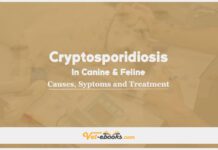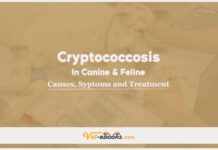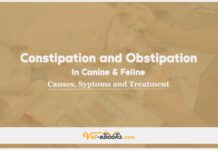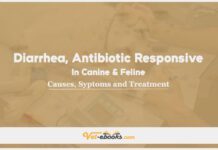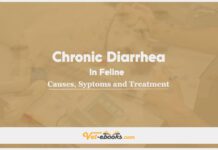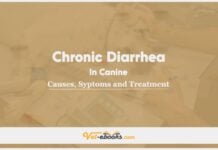Clostridial enterotoxicosis In Canine and Feline: Causes, Symptoms and Treatment
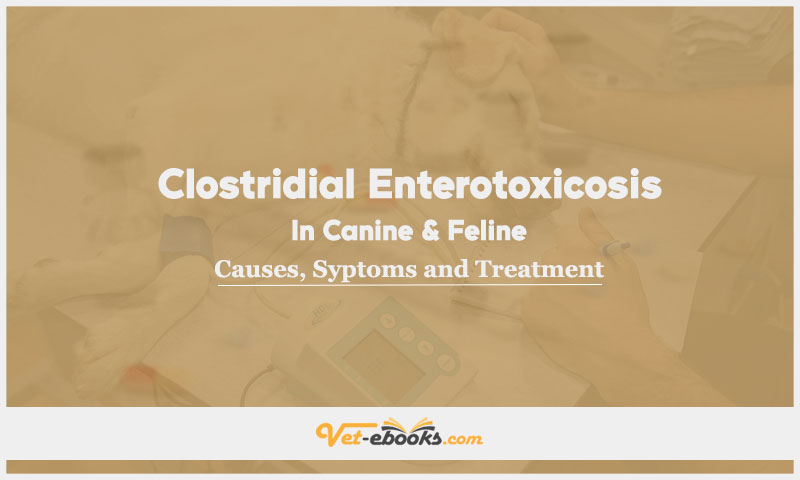
Contents
hide
Overview
Clostridial enterotoxicosis is a condition characterized by diarrhea in both dogs and cats, which is associated with the production of enterotoxin by the normal bacterial flora in the gastrointestinal tract.
Causes of Clostridial enterotoxicosis In Canine and Feline
Causes
- In humans, diarrhea associated with Clostridium perfringens (CP) typically results from consuming enterotoxigenic strains of the bacterium.
- In dogs, it is believed to occur as a consequence of disturbances in the intestinal microenvironment.
- Anything that disrupts the normal balance of gut bacteria can promote the overgrowth of CP and lead to diarrhea.
- CP toxins have also been linked to acute hemorrhagic diarrhea syndrome (AHDS) in dogs.
Risk factors
- Dietary changes.
- Use of antibiotics.
- Stress.
- Primary bacterial overgrowth in the small intestine.
Pathogenesis of Clostridial enterotoxicosis In Canine and Feline
- Clostridium perfringens is a commonly occurring bacterium in the digestive system, typically residing in its vegetative form while maintaining a mutually beneficial relationship with the host.
- Certain strains of C. perfringens, primarily type A as determined through PCR analysis, can produce an enterotoxin that binds to the intestinal lining, modifies cell permeability, and causes damage to cells, ultimately leading to the death of local enterocytes. However, this typically does not result in systemic illness.
- The production of C. perfringens enterotoxin is likely associated with the process of intestinal sporulation.
- Several intrinsic host-related factors influence the production of this enterotoxin and the pathogenicity of C. perfringens.
- The extent of C. perfringens pathogenicity may rely on the overall health and functioning of the gastrointestinal tract, including its metabolic, mucosal, and immunologic aspects.
- There is a possibility that IgA deficiency plays a role in this process.
- An alkaline environment in the intestinal lumen can encourage sporulation of C. perfringens and the production of its enterotoxin.
- The exact incidence of this condition remains unknown, but it is suspected to contribute to up to 20% of cases of chronic large bowel diarrhea in dogs. In contrast, C. perfringens infection is less common in cats than in dogs.
Symptoms (History & Physical Examination) of Clostridial enterotoxicosis In Canine and Feline
History
- Most animals affected by this condition are typically in the middle-aged or older stage. There are no specific tendencies based on sex or breed.
- Historically, affected animals have presented with symptoms of large-bowel diarrhea, often accompanied by the presence of mucus and small amounts of fresh blood. Reports commonly mention tenesmus, which is a frequent urge to have a bowel movement with increased frequency.
- In some cases, signs of small-bowel diarrhea, characterized by the passage of large volumes of watery stool, have also been observed. Additional symptoms may include vomiting, flatulence, and abdominal discomfort.
- Severity varies from mild, self-limiting diarrhea to fatal, acute, hemorrhagic diarrhea.
- Various stress factors affecting the gastrointestinal tract, dietary changes, concurrent illnesses, or hospitalization can potentially trigger the onset of these symptoms.
Physical examination
- The symptoms are typically linked to one of the following scenarios:
1- An acquired, short-lived episode of large-bowel diarrhea that lasts for about 5 to 7 days.
2- Ongoing intermittent diarrhea.
3- Symptoms related to other gastrointestinal or non-gastrointestinal diseases.
- In cases of chronic disease, the pattern often involves sporadic episodes occurring every 2 to 4 weeks, potentially persisting for several months to years.
- It’s possible for this syndrome to emerge as a result of a hospital-acquired infection, with signs appearing either during or shortly after hospitalization or kennel boarding.
- On occasion, C. perfringens may be associated with cases of parvovirus and acute hemorrhagic gastroenteritis.
- Discomfort in the abdomen.
- Passage of bloody stools (hematochezia).
- Presence of mucus in the feces.
- Dehydration may occur in cases of extensive diarrhea or vomiting.
- Fever is not a common symptom.
Diagnosis of Clostridial enterotoxicosis In Canine and Feline
1- From History and Physical Examination
2- Diagnostic Procedures
- Abdominal ultrasound serves as a valuable tool to exclude other gastrointestinal diseases.
- Additionally, colonoscopy and endoscopy, along with subsequent biopsy, can be employed to confirm the presence of acute mucosal necrosis, neutrophilic infiltration, and the adherence of rod-shaped bacteria to these necrotic regions. This procedure is also useful for ruling out alternative causes of gastrointestinal diseases.
Pathological findings
- Pathological observations often reveal mucosa that is visibly hyperemic or ulcerated.
- As well as acute destruction of the intestinal mucosa and the infiltration of neutrophils.
- Immunohistochemical staining may indicate the presence of clostridial antigen on bacterial plaques situated on necrotic areas.
CBC/Biochemistry/Urinalysis
- In cases of dehydration, several markers may show abnormalities, including an increased packed cell volume (PCV) due to hemoconcentration, elevated total plasma protein levels, heightened amylase levels, and increased blood urea nitrogen (BUN) as a result of prerenal azotemia.
- Dogs with Acute Hemorrhagic Diarrhea Syndrome (AHDS) typically exhibit elevated PCV levels, which are disproportionately high compared to their total plasma protein levels.
- Additionally, there may be leukocytosis with an increase in neutrophils and monocytes.
- Albumin levels may be decreased due to losses and reduced production, while alanine aminotransferase (ALT) and aspartate aminotransferase (AST) activities may be increased due to organ hypoxia resulting from hypovolemia.
Microbiology
- Fecal culture alone should not be relied upon to diagnose CP-associated illness since the organism is typically a normal commensal. CP can be isolated from the feces of more than 80% of healthy dogs and 43–63% of normal cats.
- Fecal endospore cultures are not useful since sporulation of enterotoxigenic CP strains occurs in dogs with and without diarrhea.
Enterotoxin Assay
- The current recommendation for identifying CPE in patients with diarrhea suspected to be due to CP is a fecal ELISA.
- However, it’s important to note that CPE is present in the feces of 5–14% of clinically normal dogs, so the clinical utility of this test may vary.
- Fecal ELISA should be combined with PCR to detect enterotoxigenic strains.
- Real-time polymerase chain reaction (RT-PCR) for detecting the CPE gene and the alpha toxin gene is also available, but the presence of the CPE gene in a dog with gastrointestinal disease does not necessarily confirm CP as the cause.
Fecal Cytology
- Microscopic examination of heat-fixed thin fecal smears stained with Romanowsky-type stain (e.g., Diff-Quik®), Wright’s stain, or new methylene blue may reveal CP endospores, which are characterized by a “safety-pin” appearance with an oval shape and a dense body at one end of the spore wall.
- However, the presence of high numbers of CP endospores on fecal cytology does not consistently correlate with clinical disease or fecal CPE activity.
- High numbers of fecal endospores can also be found in the feces of healthy dogs.
3- Differential Diagnosis
- It is important to consider all potential causes of diarrhea, including both systemic or metabolic diseases and specific intestinal disorders.
- Other factors that can lead to acute enterocolitis encompass dietary indiscretion, inflammatory bowel disease (IBD), the presence of neoplasms (particularly gastrointestinal lymphoma), medications such as antibiotics, exposure to toxins like lead, parasitic infections (such as cryptosporidiosis, trichomoniasis, whipworms, and giardiasis), various infectious agents (such as parvovirus, Feline Infectious Peritonitis [FIP], salmonellosis, rickettsia, bacterial overgrowth in the GI tract, histoplasmosis, leishmaniasis, and pythiosis), systemic organ dysfunction (involving the kidneys, liver, pancreas, and heart), and metabolic conditions (like hypoadrenocorticism and feline hyperthyroidism).
Treatment of Clostridial enterotoxicosis In Canine and Feline
General
- Currently, there are no treatment recommendations supported by scientific research for managing patients with CP-associated illness.
- For animals with mild vomiting or diarrhea, outpatient care involving antiemetic medications and subcutaneous fluids may be sufficient.
- In cases of more severe symptoms like diarrhea, vomiting, dehydration, or signs of hypovolemia, hospitalization with intravenous replacement of crystalloid fluids and antiemetics is advisable.
- Diet modification can play a role in the treatment and management of cases with chronic recurring disease.
- Diets rich in either soluble (fermentable) or insoluble fiber can often lead to clinical improvement by reducing the presence of CP in the intestines.
- This may occur through the acidification of the distal intestine, limiting CP sporulation and enterotoxin production.
- Commercial diets can be supplemented with psyllium (1/2–2 tsp/day) as a source of soluble fiber.
- Diets low in fiber should be supplemented with fiber (coarse bran 1–3 tbs/day) for insoluble fiber or psyllium added as a source of soluble fiber.
- Additionally, probiotics may assist in restoring the normal intestinal microbiota, potentially reducing the risk of recurrent CP-associated diarrhea.
- It’s important to note that acute disease often resolves on its own. There have been no documented reports of CP transmission from animals to humans. However, in households with immunosuppressed individuals, strict hygiene protocols should be observed.
Medications:
Antiemetics:
- Maropitant: Administer at a dosage of 1 mg/kg intravenously (IV) or subcutaneously (SC) every 24 hours.
- Ondansetron: Administer at a dosage of 0.5–1 mg/kg intravenously (IV) or orally (PO) every 24 hours.
Antibiotics:
- Antibiotics are generally not required for animals with mild disease since the infection often resolves on its own.
- In cases where there are signs of systemic illness or sepsis, antibiotics should be considered.
- Ampicillin: Administer at a dosage of 22 mg/kg intravenously (IV) every 8 hours.
- Amoxicillin: Administer at a dosage of 22 mg/kg orally (PO) every 8 hours.
- Metronidazole: Administer at a dosage of 10–25 mg/kg intravenously (IV) or orally (PO) every 12 hours for 5–7 days.
- Tylosin: Administer at a dosage of 5–10 mg/kg orally (PO) every 24 hours.
- Tetracyclines are no longer recommended due to resistance observed in CP isolates.
Alternative Approaches:
- Probiotics (e.g., lactobacillus) can help modify the intestinal microbiota, reducing the likelihood of recurrent episodes. One study reported faster resolution of clinical signs with probiotic use compared to no treatment.
- Consider a dietary change after the resolution of clinical signs.
Some Notes:
- In general, the prognosis is excellent, with many animals experiencing the resolution of symptoms without requiring in-patient care.
- However, in cases of acute hemorrhagic diarrhea, prompt and intensive treatment along with hospitalization is essential.
- When the animal responds well to treatment, the prognosis remains positive.
- Inform pet owners that acute cases often resolve on their own.
- For chronic cases, inform owners that prolonged treatment may be necessary.
- Explain that infection can lead to environmental contamination, making effective disinfection challenging.
- Suggest that feeding high-fiber diets may reduce the likelihood of hospital-acquired diarrhea.
- Reassure that most animals respond well to treatment, although persistent chronic cases might require lifelong therapy for symptom management.
- Emphasize that a lack of response to treatment could indicate the presence of concurrent diseases, such as parvovirus, acute hemorrhagic gastroenteritis (HGE), or inflammatory bowel disease (IBD), necessitating further diagnostic assessment.
Tip
Do You Want To Increase Your Veterinary Knowledge and Practical Skills?
You Can Now Browse and Download +3000 Books For Veterinary Professionals & Students Online.
Download Veterinary Books

